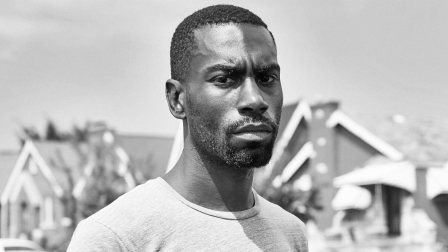Stay Woke–With Help From A Bot
For DeRay Mckesson and his fellow Black Lives Matter activists, Twitter is a double-edged sword.
The social media platform has made it easy for Mckesson to post messages, amass a dedicated digital following (half a million strong, and growing), and influence real-world events. But Twitter has also become a burden as Mckesson and other movement leaders grapple with how to counter critics and trolls. Even responding to friendly but repetitious questions, and writing the same answer countless times, can become a source of strain.
Enter Feel Train, a Portland-based creative technology studio founded by Courtney Stanton and Darius Kazemi. Both have made careers out of building technology projects with personality (one of Kazemi’s bots, for example, enthusiastically generates a new metaphor every two minutes). Kazemi and Mckesson met at the Eyeo Festival in Minneapolis last June, and began discussing ideas for a Twitter bot that would inspire Black Lives Matters supporters to “stay woke” and further their cause with concrete actions; for example, calling their local congressman’s office.
“DeRay was concerned about morale in the black community, and wanted to give people a joyous interaction,” says Kazemi. He and Stanton volunteered to complete the work pro bono, using a prior project of Stanton’s as their inspiration.
The result is @staywokebot, an experiment in activist automation. When a Twitter user follows the account, the bot responds with a tweet of affirmation, each message laced with pop culture references to black icons like Beyoncé, Oprah, and Steph Curry. “A champion with dignity, you crip walk on the hate, you embody Serena Williams, your determination makes you great,” reads one reply.
In addition, @staywokebot auto-replies to tweets that mention its Twitter handle and include a geographic location. The bot’s response contains names and phone numbers for the U.S. senators representing the recipient’s zip code.
“We’re still learning the possibilities,” says Samuel Sinyangwe, a Black Lives Matter organizer who helped create the bot. At the moment, he says, “It’s to encourage people, and in a way that’s not intimidating. The bot is like your friend. It wants to help you become a more empowered activist. You feel comfortable with it.”
That comfort is by design. “DeRay and Sam, it’s their voices,” Stanton says. “We’re just trying to give them the space to reach their audience and be effective.”
Going forward, Sinyangwe sees opportunities to build out the bot’s knowledge around hot-button topics like black-on-black crime and police bias. “There are very common themes and we want to give people a way of responding that summarizes a complicated body of research into a tweet,” he says. “That’s the long-term vision.”
In its current form, @staywokebot runs off a Google spreadsheet that the activists can update on the fly. Adding the functionality Sinyangwe envisions would involve identifying key words that a follower might tweet, like “gun control,” and composing a standard response tweet that links to data or another resource. Many bots are starting to use sophisticated artificial intelligence techniques to develop the content that they post, but relying on a spreadsheet makes it easy for non-technical bot managers like Mckesson to make adjustments over time, particularly as breaking news stories develop.
Activists like Mckesson and Sinyangwe see bots as a way to help activists “scale themselves,” to use the parlance of Silicon Valley, by freeing up their human masters’ time to focus on other tasks. In practice, that can also mean handing off responsibilities to a robot that might cause a human anxiety or distress. For example, Feel Train has developed private bots for other activists, pro bono, that mute Twitter users who use hate speech key words in their replies. By the time the activist looks at his or her Twitter notifications, the nasty tweets are gone.
Tools like private bots, Kazemi says, “are about giving you control over the emotional space that you get to inhabit on the Internet.”
But that space seems to be harder and harder protect. Twitter and other social platforms are increasingly contested public forums, with much of the vitriol instigated rather than quelled by malicious bots that have been designed to create spam or harass other users. A bot can say things that would never fly in polite, offline company, and respond at any hour of the day or night. It can espouse an extreme view without fear, and launch an ad hominem attack without shame.

“I don’t think Twitter should outright ban bots,” says Sam Woolley, who researches computational propaganda at the University of Washington. “Good bots are acting like information radiators for activists; they can be used as a social or civil prosthesis for communities that lack voice. But they shouldn’t be a way for the most powerful to gain an advantage.”
After all, collectively, bots are becoming influencers. Fake-follower bots are shaping our impressions of presidential candidates, as when Mitt Romney’s Twitter account gained 100,000 followers in a single weekend, in what some partisan commentators pegged as a desperate attempt to assert his popularity. Bot-farm armies in Mexico and Turkey have taken over activist hashtags, “Twitter-bombing” conversations in order to reduce the media’s utility as a public messaging tool. Woolley is in the process of compiling case studies on noteworthy political bot attacks from around the world.
“Bots will be used as an extension of the dirty politics used in campaigns,” he predicts. Plus, those tactics will be hard to regulate, as much of the bot activity between now and November—whether buying fake followers, Twitter-bombing hashtags, rumor mongering, or something else—will likely be carried out by third-party players operating without the official sanction or support of the campaigns.
If he’s right, it may get harder for activists on Twitter to be heard above the fray in the months leading up to November, making tools like @staywokebot even more essential for grassroots campaigners trying to influence voters without burning themselves out.
*An earlier version of this story incorrectly attributed the development of @staywokebot to Darius Kazemi alone. In fact, he collaborated with Courtney Stanton, his partner at Feel Train. The story has been updated to reflect Stanton’s role.
Fast Company , Read Full Story
(26)













